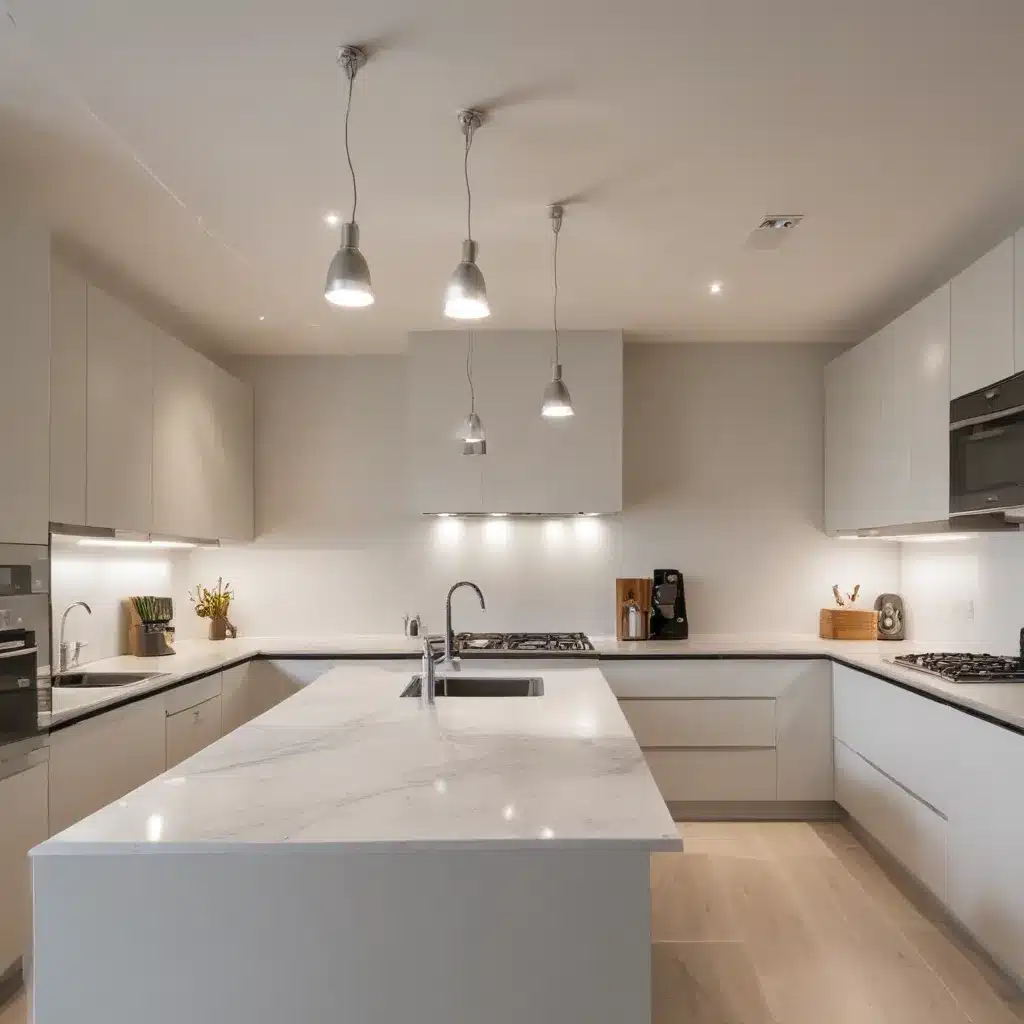
Electrical Regulations and Compliance
When undertaking a kitchen renovation, ensuring that the new lighting design meets all applicable electrical codes and safety standards is crucial. From the 2010 ADA Standards for Accessible Design, we know that newly constructed or altered state and local government facilities, public accommodations, and commercial kitchens might want to comply with detailed requirements for accessibility, including provisions for lighting.
Beyond accessibility, the WELL Building Standard emphasises the importance of quality lighting design for occupant health and wellbeing. Proper lighting can enhance productivity, mood, and overall satisfaction in the kitchen workspace. However, achieving this balance requires careful planning to meet electrical regulations.
The 2010 ADA Standards set minimum technical requirements for lighting fixtures, controls, and placement. Additionally, local building codes will have specific rules governing electrical installations, wiring, and safety features. Consulting these guidelines early in the design process is essential to double-check that your kitchen renovation project remains compliant.
Optimising Lighting Efficiency
One of the primary goals in kitchen lighting design should be maximising energy efficiency. Sustainable construction practices recommend using LED lighting, which offers superior luminous efficacy and reduced power consumption compared to traditional incandescent or halogen bulbs.
Thoughtful placement of task lighting, ambient overhead fixtures, and accent lighting can also contribute to energy efficiency. For example, under-cabinet lighting can illuminate work surfaces while minimising the need for bright overhead fixtures. Dimmable lighting controls allow residents to adjust brightness levels based on their needs, further enhancing energy savings.
Incorporating natural daylight through strategically placed windows or skylights is another effective way to optimise lighting efficiency in the kitchen. This “daylighting” approach can significantly reduce reliance on artificial lighting during daytime hours. Just be sure to coordinate natural and electric lighting sources to avoid uneven illumination or glare.
Aesthetic Considerations
While function and efficiency are paramount, the aesthetic appeal of a kitchen’s lighting design should not be overlooked. Striking a balance between practical and decorative elements can dramatically enhance the overall design and ambience of the space.
Pendant lights, for instance, can serve as both task lighting above a kitchen island or dining table, as well as an eye-catching architectural feature. Recessed ceiling fixtures can provide a clean, unobtrusive look, while strategically placed accent lights can showcase beautiful cabinetry, backsplashes, or other design details.
Integrating the lighting plan with the kitchen’s overall style – whether contemporary, traditional, or something in between – is key to achieving a cohesive and visually appealing result. Homeowners should work closely with their renovation team to explore lighting options that complement the kitchen’s materials, finishes, and layout.
Lighting Types and Applications
Task Lighting
Proper task lighting is essential in a kitchen, where activities like food preparation, cooking, and cleaning require high-quality, focused illumination. Under-cabinet lighting is a popular and practical solution, providing direct light to countertops and work areas. Pendant lights suspended over islands or tables can also serve as effective task lighting sources.
Ambient Lighting
In addition to task lighting, every kitchen needs a layer of general, ambient illumination. Recessed ceiling fixtures are a common choice, as they offer a clean, unobtrusive look while providing an even, diffuse glow throughout the space. Dimmable ambient lighting allows residents to adjust brightness levels to suit their needs and preferences.
Accent Lighting
Accent lighting can be used to highlight specific architectural features, artwork, or design elements within the kitchen. Undercabinet lighting directed upwards can accentuate the texture and colour of cabinetry. Directional track lighting or subtle wall sconces can draw attention to decorative backsplashes or other focal points.
Lighting Control and Automation
Advancing smart home technologies offer kitchen renovators exciting opportunities to incorporate intelligent lighting control systems. These systems allow residents to programme lighting schedules, adjust brightness levels, and even integrate lighting with other home automation features.
From a practical standpoint, automated lighting can contribute to energy savings by ensuring lights are turned off when not in use. Residents can also tailor lighting levels to their preferences, creating the ideal ambience for meal preparation, dining, or entertaining.
Beyond energy management, integrated lighting controls can enhance the overall user experience and convenience in the kitchen. Homeowners may programme lighting scenes to suit different activities, or tie the system into voice commands or motion sensors for hands-free operation.
Practical Considerations
Installation and Wiring
Proper electrical wiring and fixture installation are essential for ensuring both the safety and long-term functionality of a kitchen’s lighting system. Consulting a licensed electrician early in the renovation process is highly recommended to assess the existing electrical infrastructure and determine any necessary upgrades or modifications.
The electrician will be able to advise on the best practices for integrating new lighting fixtures, switches, and controls into the kitchen’s electrical system. They can also help to optimise the placement and layout of lighting components for maximum efficiency and accessibility.
Maintenance and Upgrades
Just as important as the initial installation is the ongoing maintenance of a kitchen’s lighting system. Homeowners should familiarise themselves with recommended lamp replacement schedules, cleaning procedures for fixtures, and strategies for adapting to future lighting advancements.
As technology continues to evolve, kitchen renovators should also consider the flexibility to incorporate new lighting solutions and control systems down the line. Designing with adaptability in mind can double-check that the lighting design remains functional and up-to-date for years to come.
By carefully considering electrical regulations, optimising energy efficiency, and balancing aesthetic appeal, homeowners can create a kitchen lighting plan that is both practical and visually stunning. Consulting experts, leveraging the latest technologies, and remaining vigilant about maintenance will all contribute to a successful, compliant, and long-lasting kitchen renovation.
Tip: Schedule regular maintenance to double-check that proper functioning of plumbing and electrical systems
















